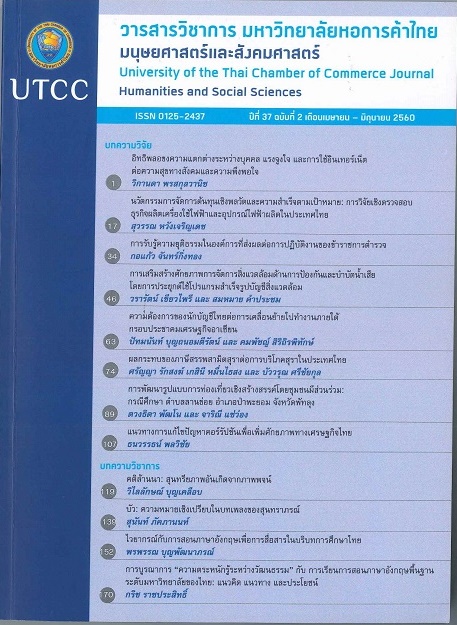Innovation of Dynamic Cost Management and Goal Achievement: An Empirical Investigation of Electronics and Electrical Manufacturing Businesses in Thailand
Main Article Content
Abstract
The objective of this study is to empirically investigate the effects of innovation of dynamic cost management on goal achievement through cost utilization fitness, productivity efficiency proficiency and value enhancement. Furthermore, the moderating effect of organizational learning capability is also investigated. The electronics and electrical manufacturing businesses in Thailand, 303 companies, are used as the samples. Questionnaire was used to collect data. Data were then analyzed by using the Ordinary Least Squares (OLS) method of regression analysis. Results indicate that innovation of dynamic cost management has positive impact on goal achievement through consequences as the mediators. In addition, for moderating effects,
organizational learning capability has shown partially positive supported between dynamic cost management innovation and consequences. The results can be a useful cost management process link to operation, and to enhance its success via dynamic competitive advantage and continuous corporate survival.
Article Details
ลิขสิทธิ์ของบทความ
ผลงานที่ได้รับการตีพิมพ์ถือเป็นลิขสิทธิ์ของมหาวิทยาลัยหอการค้าไทย ห้ามมิให้นำเนื้อหา ทัศนะ หรือข้อคิดเห็นใด ๆ ของผลงานไปทำซ้ำ ดัดแปลง หรือเผยแพร่ ไม่ว่าทั้งหมดหรือบางส่วนโดยไม่ได้รับอนุญาตเป็นลายลักษณ์อักษรจากมหาวิทยาลัยหอการค้าไทยก่อน
References
Anderson, M., Asdemir, Q., & Tripathy, A. (2013).Use of precedent and antecedent information in strategic cost management.Journal of Business Research, 66(5), 643- 650.
Archie L. (2003). A constraint-based framework for strategic cost management. Industrial Management & Data Systems, 103, 591-599.
Baden-Fuller, C., & Volberda, H. (1997).Strategic renewal: How large complex organizations prepare for the future.International Studies in Management and Organization, 27(2), 95-120.
Bandura, A. (1999). A social cognitive theory of personality. In L.A. Pervin & O.P. John (Eds.), Handbook of personality: Theory and research (pp. 154-196) (2nd ed.).
New York: The Guilford Press.Biddle, G., & Hilary, G. (2006). Accounting quality and firm-level capital investment.
The Accounting Review, 81, 963-982.
Buciuniene, I., & Kazlaurskaite, R. (2012). The linkage between HRM, CSR and performance outcomes. Baltic Journal of Management, 7(1), 5-24.
Chenhall, R. H. (2003). Management control systems design within its organizational context finding form contingency-based research and direction for the future. Accounting Organizational and Society, 28(2-3), 127-168.
Cinquini, L., & Tenucci, A. (2010). Strategic management accounting and business strategy: A loose coupling. Journal of Accounting Organizational Change, 6(2), 228-259.
Cronbach, L. J. (1951). Coefficient alpha and internal structure of tests. Psychometrical,16(3), 297-334.
Dekker, H., & Smidt, P. (2003). A survey of the adoption and use of target costing in
Dutch Firms. International Journal Production Economics, 84(3), 293-305.
Grant, R. M. (1996). Toward a Knowledge- Based Theory of the Firm. Strategic Management Journal, 17, 109-122.
Hair, J. F., Black, W. C., Babin, B. J., & Anderson, R. E. (2006). Multivariate data analysis (7th ed.). Upper Saddle River, NJ: Prentice Hall.
Hewett, K., Roth, M S., & Roth, K. (2003). Conditions influencing headquarters and foreign subsidiary roles in marketing activities and their effects on performance. Journal of International Business Studies, 34, 567-585.
Krejcie, R.V., & Morgan, D. W. (1970). Determining sample size for research activities.Psychological Measurement, 30, 607-610.
Martinette, L. (2014). Relationship between learning orientation and business performance and the moderating effect of competitive advantage: An accounting service firm’s perspective. International Business & Economics Research Journal,13, 779-792.
Picur, D. R. (2007). The effects of accounting knowledge on the omission of value added information in wealth measurement and distribution decisions. Review of Accounting and Finance, 6(1), 15-23.
Santa, R., Ferrer, M., Bretherton, P., & Hyland,P. (2009). The necessary alignment between technology innovation
effectiveness and operational effectiveness. Journal of Management and Organization,15(2), 155-169.
Valanciene L., & Gimzauskiene, E. (2007). Does implementation of modern management accounting conceptions ensure corporate value creation?.Economics and Management, 12 (5),154-164.
Wang, H.W., & Wu, M.C. (2012). Business type industry value chain and R&D performance: Evidence from High-Tech Firms in an Emerging Market. Technological Forecasting & Social Change, 79(2), 326-340.
Wangcharoendate, S. (2015). Internal auditoutsourcing and sustainable audit success: An empirical investigation of listed companies in the Stock Exchange of Thailand. University of the Thai Chamber of Commerce Journal, 35(1), 1-21.

